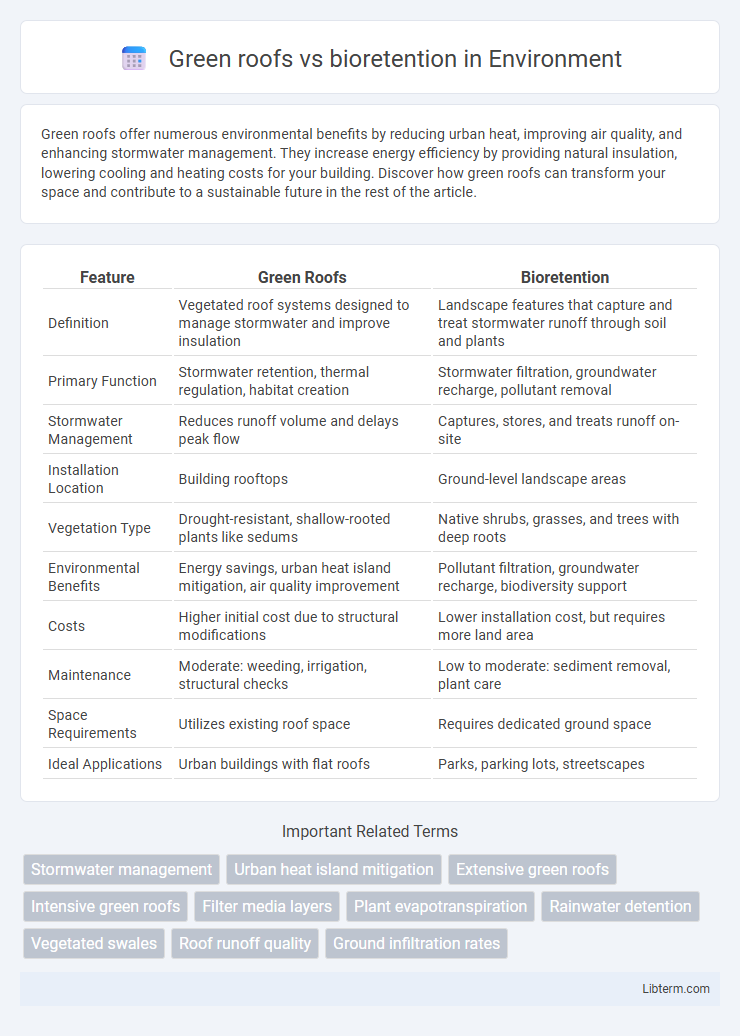Green roofs offer numerous environmental benefits by reducing urban heat, improving air quality, and enhancing stormwater management. They increase energy efficiency by providing natural insulation, lowering cooling and heating costs for your building. Discover how green roofs can transform your space and contribute to a sustainable future in the rest of the article.
Table of Comparison
| Feature | Green Roofs | Bioretention |
|---|---|---|
| Definition | Vegetated roof systems designed to manage stormwater and improve insulation | Landscape features that capture and treat stormwater runoff through soil and plants |
| Primary Function | Stormwater retention, thermal regulation, habitat creation | Stormwater filtration, groundwater recharge, pollutant removal |
| Stormwater Management | Reduces runoff volume and delays peak flow | Captures, stores, and treats runoff on-site |
| Installation Location | Building rooftops | Ground-level landscape areas |
| Vegetation Type | Drought-resistant, shallow-rooted plants like sedums | Native shrubs, grasses, and trees with deep roots |
| Environmental Benefits | Energy savings, urban heat island mitigation, air quality improvement | Pollutant filtration, groundwater recharge, biodiversity support |
| Costs | Higher initial cost due to structural modifications | Lower installation cost, but requires more land area |
| Maintenance | Moderate: weeding, irrigation, structural checks | Low to moderate: sediment removal, plant care |
| Space Requirements | Utilizes existing roof space | Requires dedicated ground space |
| Ideal Applications | Urban buildings with flat roofs | Parks, parking lots, streetscapes |
Introduction to Green Roofs and Bioretention
Green roofs consist of vegetative layers installed on rooftops to manage stormwater, reduce urban heat island effects, and improve air quality. Bioretention systems, also known as rain gardens, are engineered landscape features that filter and absorb runoff through soil and plants, promoting groundwater recharge. Both green roofs and bioretention play essential roles in sustainable urban water management by mitigating pollution and controlling stormwater flow.
Key Features of Green Roof Systems
Green roof systems feature layered components including waterproof membranes, root barriers, drainage layers, and a growing medium that supports diverse vegetation, promoting stormwater retention and urban heat island mitigation. These systems also enhance insulation properties, reducing building energy consumption and improving indoor climate control. Compared to bioretention, green roofs provide elevated filtration and evapotranspiration benefits directly atop structures, maximizing limited urban space for ecological functions.
Core Principles of Bioretention Practices
Bioretention practices center on the controlled capture and treatment of stormwater through engineered soil media and vegetation layers that promote infiltration and pollutant removal. These systems utilize natural processes such as microbial degradation and filtration to improve water quality and reduce runoff volume, aligning closely with sustainable urban drainage principles. Unlike green roofs primarily designed for insulation and urban heat island mitigation, bioretention focuses on hydrologic function and water quality enhancement within ground-based landscape features.
Environmental Benefits Comparison
Green roofs improve urban air quality by filtering pollutants and reducing the urban heat island effect through increased vegetation coverage, enhancing energy efficiency and habitat creation. Bioretention systems excel in stormwater management by naturally filtering runoff, reducing nutrient loads and preventing flooding while promoting groundwater recharge. Both green roofs and bioretention contribute significantly to biodiversity, carbon sequestration, and temperature regulation, with their effectiveness varying based on site-specific conditions and implementation scale.
Stormwater Management Efficiency
Green roofs effectively reduce stormwater runoff by retaining up to 75% of rainfall, promoting evapotranspiration and delayed peak flow. Bioretention systems enhance stormwater management by filtering pollutants through engineered soil layers and vegetation, achieving infiltration rates of 0.5 to 2 inches per hour. Both methods improve water quality and reduce volume, but bioretention offers greater pollutant removal efficiency while green roofs provide additional insulation benefits.
Installation and Maintenance Requirements
Green roofs require specialized structural support, waterproof membranes, and extensive planting media, with installation typically involving professionals due to complexity and weight considerations. Maintenance includes regular irrigation, weeding, and inspection of drainage systems to prevent waterlogging and plant stress. Bioretention systems have simpler installation, involving excavation, engineered soil layers, and drainage components, and demand routine maintenance such as sediment removal, vegetation pruning, and sediment barrier inspection to ensure pollutant filtration efficiency.
Cost Analysis and Long-term Value
Green roofs typically demand higher initial installation costs ranging from $15 to $25 per square foot, whereas bioretention systems average $10 to $20 per square foot, influenced by site-specific conditions. Long-term value assessment reveals green roofs enhance building insulation, reducing energy costs by up to 30%, while bioretention provides superior stormwater management and groundwater recharge benefits. Maintenance expenses for green roofs can be lower over time due to vegetation sustainability, yet bioretention systems require periodic sediment removal and plant replacement, impacting lifecycle costs.
Urban Aesthetic and Functional Integration
Green roofs enhance urban aesthetics by introducing vibrantZhi Wu Fu Gai areas on rooftops, improving visual appeal and reducing heat island effects. Bioretention systems integrate seamlessly into streetscapes and parks, offering functional stormwater management through natural filtration while supporting native vegetation diversity. Both methods promote sustainable urban environments but differ in spatial application, with green roofs primarily elevating building aesthetics and bioretention focusing on ground-level ecological function.
Climate Adaptation and Resilience
Green roofs enhance climate adaptation by reducing urban heat islands, improving stormwater management, and providing insulation that decreases energy demand. Bioretention systems improve resilience by filtering pollutants, mitigating flood risks through water retention, and supporting biodiversity within urban landscapes. Both strategies contribute to climate resilience by managing runoff and reducing temperature extremes, but green roofs specifically optimize rooftop space while bioretention integrates with ground-level infrastructure.
Choosing the Right Solution for Your Site
Selecting between green roofs and bioretention depends on site-specific factors such as available space, soil conditions, and stormwater management goals. Green roofs are ideal for urban settings with limited ground area, offering insulation and runoff reduction, while bioretention systems excel in areas with adequate ground space for infiltrating and filtering stormwater. Evaluating site constraints, maintenance capacity, and environmental benefits ensures the most effective sustainable water management strategy.
Green roofs Infographic

 libterm.com
libterm.com